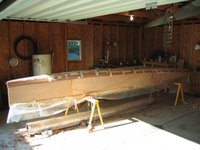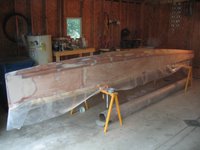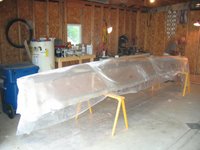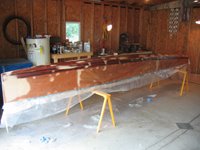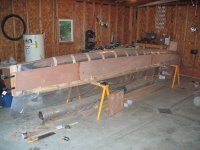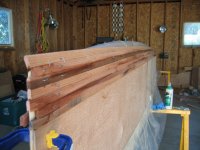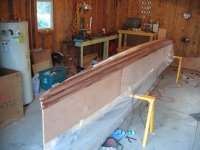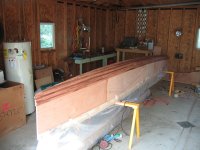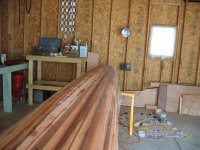As you may recall, from earlier posts, I delayed the project for one summer due to planning a wedding and preparing to move. I ended up having to delay it yet another summer as the winter before that I was among the many laid off that year. Now, however, I am back to working full time and in a new garage so things can move forward.
 These first two photos are the completed hulls with bulkhead and substructure for support. There is a reason why they look different. When you apply fiberglass it is not initially smooth. The texture of the glass cloth needs to be filled in and sanded. The first hull was filled in with straight epoxy by applying two or three extra coats. Since the completion of that hull friends of mine had found a faster way of filling in the glass cloth. It is simply a fairing compound, or a specific powder additive added to the epoxy. This is spread over the glass and sanded. And it is a lot easier to sand then the straight epoxy coat which I discovered at the beginning of this summer.
These first two photos are the completed hulls with bulkhead and substructure for support. There is a reason why they look different. When you apply fiberglass it is not initially smooth. The texture of the glass cloth needs to be filled in and sanded. The first hull was filled in with straight epoxy by applying two or three extra coats. Since the completion of that hull friends of mine had found a faster way of filling in the glass cloth. It is simply a fairing compound, or a specific powder additive added to the epoxy. This is spread over the glass and sanded. And it is a lot easier to sand then the straight epoxy coat which I discovered at the beginning of this summer.
 This was also the last thing I did to the hulls in my old garage prior to packing up and moving.
This was also the last thing I did to the hulls in my old garage prior to packing up and moving.
Once I began working on the hulls again, it was a matter of sanding them and getting a coat of primer on them. I wanted at least one coat of primer done while the hulls were separate - might as well when it is a bit easier, right? So I spent a good portion of two to three months sanding, and I am so glad I am done with sanding.

And yes, this is me priming the hulls.
 Now on to the fun part. Joining the hulls. To join the hull I needed a holding jig to hold the hulls in alignment properly to each other. This jig is simply a frame made out of half inch plywood with a couple uprights to hold the hull. The trick with this is to make sure the jig is square so the hulls will be square.
Now on to the fun part. Joining the hulls. To join the hull I needed a holding jig to hold the hulls in alignment properly to each other. This jig is simply a frame made out of half inch plywood with a couple uprights to hold the hull. The trick with this is to make sure the jig is square so the hulls will be square.
 With the jig made and squared I could set the hulls.
With the jig made and squared I could set the hulls.
 For the finished look, I wanted to have the cross beams set into the hull about half way. To do this I needed to cut a notch into the hull sides to receive the 3 1/2 inch diameter aluminum tubes. This allows them to set directly onto the bulkheads (the side to side vertical wall seen at the bottom of the cut).
For the finished look, I wanted to have the cross beams set into the hull about half way. To do this I needed to cut a notch into the hull sides to receive the 3 1/2 inch diameter aluminum tubes. This allows them to set directly onto the bulkheads (the side to side vertical wall seen at the bottom of the cut).
The cross beams are set in place.

 Here you can see the strip of fiberglass holding the beam to the bulkhead. Once the deck is on I will use additional strips of carbon fiber for added strength.
Here you can see the strip of fiberglass holding the beam to the bulkhead. Once the deck is on I will use additional strips of carbon fiber for added strength.
There are a few more internal items to take care of before putting on the deck. These include making a daggerboard box. The daggerboard is a type of keel which keeps the boat tracking straight and is inserted through a hole in the hull from the top. The daggerboard box is a sleeve which connects the deck and the bottom of the hull allowing this to happen without it leaking. For those of you who are involved with A class catamarans, I am using a pair of A3 daggerboards.

Other items include rudder heads (the bracket for mounting the rudders) and trampoline hooks. The trampoline is the material between the two hulls which I sit on while sailing. And yes it is the same material as a trampoline, just no springs.
 I have been able to set the forward section of the deck however, as there is not much happening in that section of the boat. When finished the hull bottom will be painted white and the deck will be natural wood with about 3/4 inch strip of white on the edge to hide the screw holes when gluing the deck down.
I have been able to set the forward section of the deck however, as there is not much happening in that section of the boat. When finished the hull bottom will be painted white and the deck will be natural wood with about 3/4 inch strip of white on the edge to hide the screw holes when gluing the deck down.
So that is where I am at now. I will keep you posted a little more often as I go and hopefully will have the boat in the water this summer yet.




















